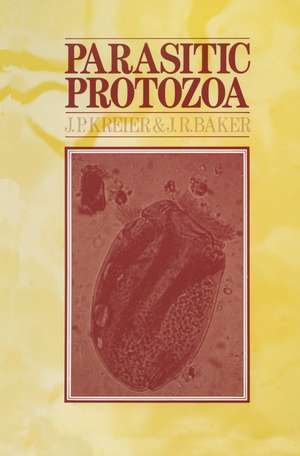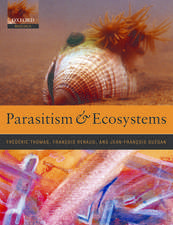Parasitic Protozoa
Autor J.P. Kreier, J. R. Bakeren Limba Engleză Paperback – 31 iul 1987
Preț: 385.84 lei
Nou
Puncte Express: 579
Preț estimativ în valută:
73.84€ • 76.89$ • 62.41£
73.84€ • 76.89$ • 62.41£
Carte tipărită la comandă
Livrare economică 10-24 martie
Preluare comenzi: 021 569.72.76
Specificații
ISBN-13: 9780045910229
ISBN-10: 0045910227
Pagini: 256
Ilustrații: 256 p.
Dimensiuni: 155 x 235 x 14 mm
Greutate: 0.36 kg
Editura: SPRINGER NETHERLANDS
Colecția Springer
Locul publicării:Dordrecht, Netherlands
ISBN-10: 0045910227
Pagini: 256
Ilustrații: 256 p.
Dimensiuni: 155 x 235 x 14 mm
Greutate: 0.36 kg
Editura: SPRINGER NETHERLANDS
Colecția Springer
Locul publicării:Dordrecht, Netherlands
Public țintă
ResearchCuprins
1 Classification and evolution of the symbiotic protozoa.- Classification.- Evolution.- Further reading.- 2 Anatomy and physiology of the protozoa.- Anatomy.- Physiology.- Further reading.- 3 Trypanosomes and related organisms.- Suborder 1: Bodonina.- Suborder 2: Trypanosomatina.- Genus Leishmania Ross, 1903.- Genus Trypanosoma Gruby, 1843.- Section A: Stercoraria.- Section B: Salivaria.- Diagnosis of trypanosome infections.- Treatment of leishmanial and trypanosomal infections.- Further reading.- 4 Flagellates of the alimentary and urinogenital tracts.- Class Zoomastigophorea.- Order Retortamonadida.- Order Oxymonadida.- Order Diplomonadida.- Genus Giardia Kunstler, 1882.- Order Trichomonadida.- Genus Trichomonas Donné, 1837.- Genus Dientamoeba.- Genus Histomonas Tyzzer, 1920.- Order Hypermastigida.- Subphylum Opalinata.- Further reading.- 5 Symbiotic amebae.- Genus Entamoeba Casagrandi and Barbagallo, 1895.- Other intestinal amebae of man.- Genera Acanthamoeba, 1931 and Naegleria Alexeieff, 1912.- Further reading.- 6 Gregarines, hemogregarines and intestinal coccidia.- Class Sporozoea.- Subclass Gregarinia.- Subclass Coccidia.- Order Eucoccidiida, Suborder Adeleina.- Suborder Eimeriina.- Genus Eimeria Schneider, 1895.- Genus Isospora Schneider, 1881.- Genus Toxoplasma Nicolle and Manceaux, 1909.- Genus Sarcocystis Lankester, 1882.- Genus Besnoitia Henry, 1913.- Addendum.- Further reading.- 7 Malaria parasites and their relatives.- Family Plasmodiidae.- Family Haemoproteidae.- Family Leucocytozoidae.- Further reading.- 8 Piroplasms.- Family Babesiidae.- Genus Babesia Starcovici, 1893.- Family Theileriidae.- Genus Theileria Bettencourt, França and Borges, 1907.- Genus Cytauxzoon Neitz and Thomas, 1948.- Family Dactylosomidae.- Further reading.- 9 Myxozoa, Microsporaand Ascetospora.- Phylum Myxozoa.- Order Bivalvulida.- Phylum Microspora.- Phylum Ascetospora.- Further reading.- 10 Symbiotic ciliates.- Genus Balantidium Claparède and Lachmann, 1858.- The rumen ciliates.- Further reading.- 11 Techniques.- Intestinal protozoa.- Tissue protozoa.- Further reading.- Addresses of suppliers.
Recenzii
Kreier and Baker have produced a concise, little introductory textbook, that is packed with information about the major groups of parasitic protozoa. Everyone working in classical veterinary, or medical protozoology should own a copy of this up-to-date, easy to use book - as a reference for its investigations and instructions and as a good text for beginning parasitology students. Journal of Protozoology







